After 26 years, Meet and Eat coordinator prepares to hand over reins
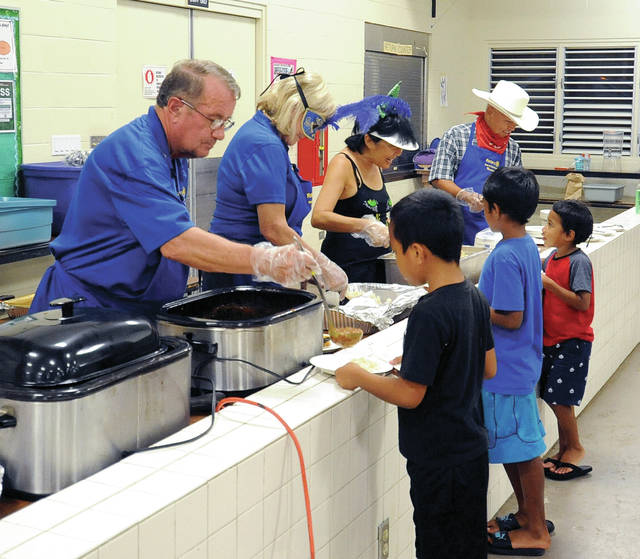
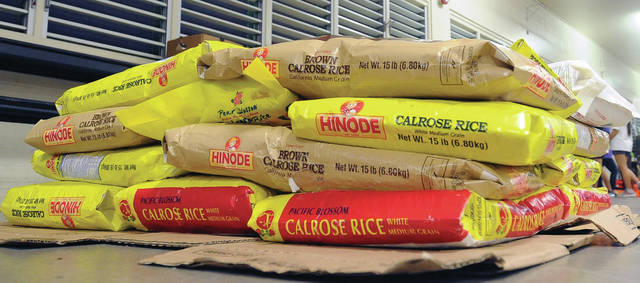
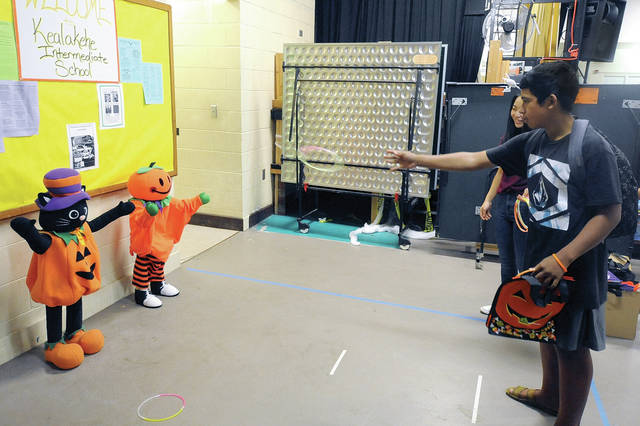
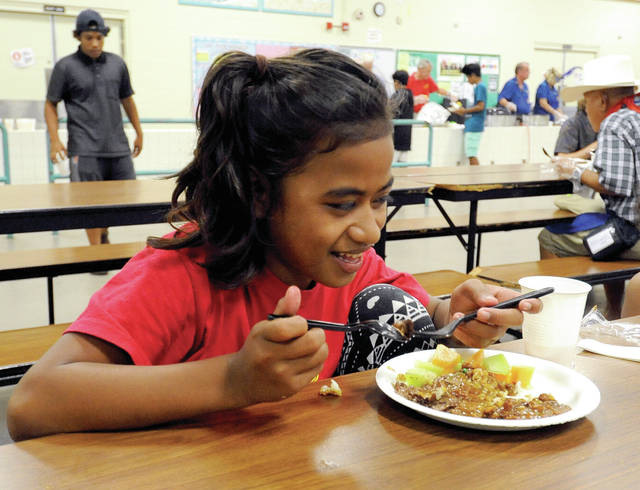
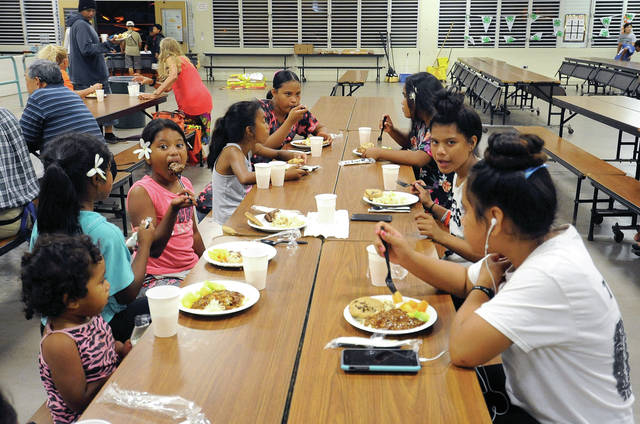
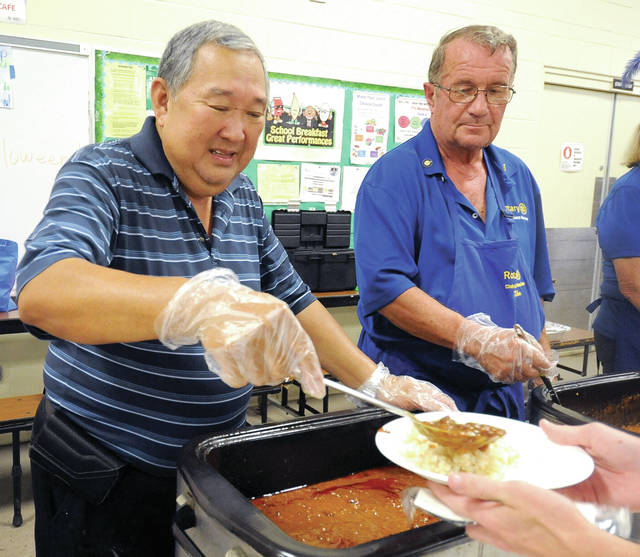
KEALAKEHE — About 6 p.m. on a recent Wednesday, a line of dinner guests — chiefly comprised of kids and teens — starts filing into the cafeteria of Kealakehe Intermediate School.
KEALAKEHE — About 6 p.m. on a recent Wednesday, a line of dinner guests — chiefly comprised of kids and teens — starts filing into the cafeteria of Kealakehe Intermediate School.
It’s been hours since classes at the school let out, and the parking lot fronting the cafeteria is all but empty.
Inside the cafeteria though it’s brightly lit, and after being handed a plate, guests make their way down the line: rice, some chili on top, then a bit of green salad and melon and finally a cupcake or cookie.
At the far end of the service line, Ardaven “Ardie” Ikeda, coordinator of the Kona Task Force on Feeding the Hungry, fills one cup after another with a mix of iced tea and fruit juice from a cooler.
Altogether, the weekly Meet and Eat, put on by the Kona Task Force on Feeding the Hungry, is a warm and welcoming operation — one that by the end of the night will have fed about 130 people, 92 of them children.
There was a time when children who came to the Meet and Eat were expected to come with their parents, Ikeda said. But with adults often unavailable to bring their kids in the evening, the rule changed.
“It’s all right with us, ” Ikeda said at a previous dinner held Halloween night, “because I’d rather they come without the parents than they not come and maybe go hungry.”
Kids, he said, make up about 80 percent of those who come to the school feedings.
By the end of the year, when Ikeda plans to retire from coordinating the weekly Meet and Eat, they’re likely to have served 250,000 meals in the last 26 years.
“But as far as I’m concerned, the numbers mean absolutely nothing,” said Ikeda. “If there’s one child that would have gone missing a meal and we were able to help the child — or anyone for that matter — then we’ve done our job. It’s not a matter of how many meals we serve, if we’re helping the ones that really need it, then that’s our purpose for being here.”
Man who made it go steps away
Asked how many staff members he has to help run an operation that feeds more than 100 people on a given night, Ikeda curls his fingers into a zero and laughs.
“We’re community-based,” he said.
Instead of a staff, he works with religious groups like Grace Community Church, civic organizations such as the Rotary Club of Kona Sunrise as well as other organizations who take turns preparing the main dish for a given week and providing volunteers to help serve and clean up.
After 26 years of the weekly dinners as the coordinator of the Kona Task Force on Feeding the Hungry (throughout which, they have only missed two weeks, both times because of hurricanes), Ikeda plans to retire from coordinating the weekly dinners at the end of this year.
“Health-wise, I’m just getting to the point where I have so many issues that it’s a good time to bring the new group in so that they can transition over to taking over the program,” he said.
Ikeda said he’s been in negotiations with the local Rotary Clubs about taking over management of the program at the end of the year.
Those who have worked with Ikeda, like long-time volunteer Sharyn Toyama, said that it’s “the grassroots, the underdog of the community that actually provides the most success in the community — program-wise — that affects a lot of people.”
“It’s the unsung heroes,” she added, gesturing to Ikeda and nodding her head, “that do programs like this.”
Kristin Frost Albrecht, executive director of The Food Basket, called Ikeda a man with “a big smile and an even bigger heart.”
“He instantly makes everybody feel comfortable,” she said.
History of helping
The Kona Task Force on Feeding the Hungry has been serving meals since 1992, started by the late Ken Clewett along with nine founding Task Force members.
Originally, Ikeda said, organizers saw a need to offer meals to low-income, single-parent families, many of whom lived in low-income housing developments around Kealakehe.
Ikeda said his involvement stems from a friend of his who worked for Cal Kona Produce, which delivered the produce, and Ikeda would come along. Every so often, when a group wasn’t able to make the food, he said, they would prepare the food for them.
“So then it just got to be something that we did every week,” he said.
It’s a weekly occurrence that makes a difference for those like Sherlina Anuntak, who came to the dinner on Halloween with her kids, ages 8 and 5, as well as her sister-in-law and nieces.
She said they had come the previous week and were so satisfied with how the program was helping the community.
“We feel love coming here, and we’re happy,” said Anuntak, who moved to Kona recently from the Marshall Islands. “There’s happiness and love we get from coming to eat from the food they provide.”
Swansong Thanksgiving dinner
With Ikeda’s retirement looming at the end of the year, it means the upcoming Thanksgiving dinner, planned for Nov. 21, will be his last. By its very nature, Thanksgiving marks the program’s largest meal of the year, drawing upward of 350 people.
It’s also the night volunteers from throughout the year are invited to come and join the meal as well, sitting down at tables with those they’ve served, demonstrating that the Meet and Eat is as much about the meeting as it is the eating.
“There’s a lot of those that come here that have the social needs that they can’t get,” Ikeda said. “And when they come here, they find that there’s people here that they can talk to. It’s almost like a new community for them, and they make new relationships here.”
This year’s Thanksgiving Meet and Eat is scheduled for Wednesday, Nov. 21, at the Kealakehe Intermediate School cafeteria. The program starts at 5:15 p.m. and will feature taiko drummers and ukulele performances. The event runs until 7 p.m.
At the end of last month, the Kona Task Force on Feeding the Hungry kicked off the collection of rice for its rice pyramid. Donations are accepted up through the Thanksgiving dinner and will be donated to The Food Basket. Ikeda said their goal is to bring in about 2,000 pounds of rice for that organization.
The Meet and Eat has a long-standing policy of welcoming anybody to the weekly feedings no-questions-asked. While many are homeless or low-income, there are others who, whatever their circumstances, simply need a meal and some company.
When Aloha Airlines went bankrupt and ended operations in 2008, Ikeda said, the Task Force told employees about the availability of meals through the Meet and Eat program.
“The thing is at any given point, you might not get your paycheck you think you’re going to get,” he said. “Or at any given point, for some reason, your house might get foreclosed on. There’s so many things that happen today that put you in a position where any one of us can be homeless tomorrow. And it may not even be for something that we did, just circumstances that make it happen.”
“And when that happens,” he added, “then it’s just good to know that there’s a place that you can go for additional support. And I think that’s the reason why we’re here.”
With the Task Force ready to cross the threshold of a quarter million plates and a passing of the torch — or serving spoon as the case may be — it’s a chance to reflect: what does the goal look like?
“The generic answer to that is ‘to end hunger.’ It’s like zero defects,” Ikeda said. “You will never get to that point, but you can get as close to it as you can. The thing is, with our feeding, it’s not a matter of trying to cure all of the evil. What we want to do is we just want to make sure that if someone needs a meal, then we’re available for them.”


